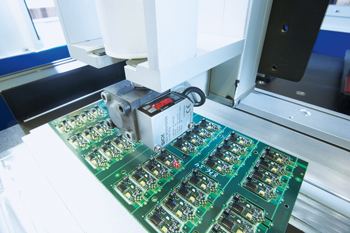All optical displacement sensors utilize one of three triangulation receiver technologies: Position Sensing Detector (PSD), Charge-Coupled Device (CCD), or Complementary Metal Oxide Semiconductor (CMOS). But which technology should you look for in an optical displacement sensor for industrial applications?
Keep reading to learn more about each technology and see why CMOS offers the most advantages.
1. Position Sensing Detector (PSD)
This receiver technology is the simplest and lowest-cost solution and is used in baseline photoelectric products. Consideration must be given where different target remissions (light color vs. dark color) are present, since the measurement values for the two remissions will differ.
In addition, the PSD receiver cannot differentiate between a direct light source and reflected light. The receiver can be “blinded” by the reflected light of high-gloss surfaces such as polished metal.
2. Charge-Coupled Device (CCD)
This version of receiver technology is common in digital cameras and video cameras. The technology has been available for years. In reference to optical displacement sensors, CCD receivers are a vast improvement over the baseline PSD style.
Even though performance with dark/light remission targets is better (compared to PSD), residual light being reflected off targets can still blind the CCD receiver.
3. Complementary Metal Oxide Semiconductor (CMOS)
The star of optical performance, CMOS receivers offer several distinct advantages over the two previous receiver designs. CMOS receivers accurately measure distances of dark and light targets. This means that whether you are measuring tire tread or polished surfaces, the measurement values will remain consistent.
CMOS receivers measure high-gloss surfaces with high accuracy and no blinding effect. This is the primary reason why digital photography is making the major move to CMOS receiver technology.
 All of SICK’s optical displacement sensors use CMOS technology, making them ideal for high performance applications in a variety of market segments including automotive, postal, electronics, packaging, robotics and general manufacturing markets.
All of SICK’s optical displacement sensors use CMOS technology, making them ideal for high performance applications in a variety of market segments including automotive, postal, electronics, packaging, robotics and general manufacturing markets.
Read the full white paper: Triangulation Receiver Technologies






